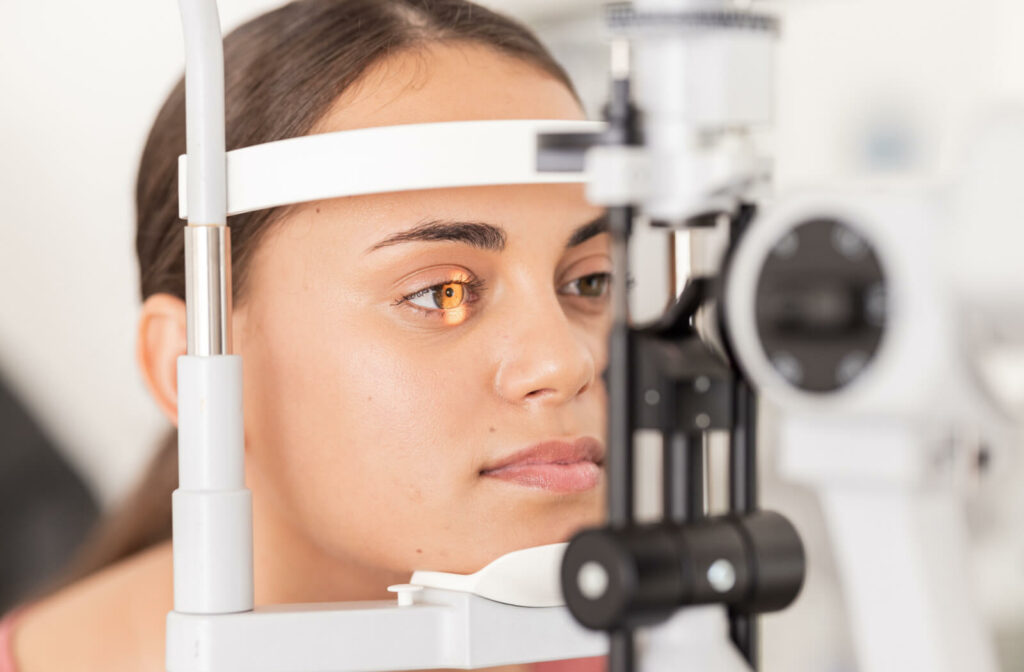Axial length refers to the distance from the front to the back of the eyes—specifically, from the cornea, the clear window at the front of the eye, to the retina, the light-sensitive tissue lining the back of the eye. This number is important as it lets an optometrist know exactly how misshapen an eye is so they can begin appropriately treating the problem.
Two common refractive errors—myopia (nearsightedness) and hyperopia (farsightedness)— are caused by the eye being misshapen in some way and can lead to significant vision troubles if left untreated. An optometrist can determine whether or not you or your child are developing vision problems by measuring the axial length of your eye during adult eye exams and children’s eye exams.
Understanding Axial Length
Your eye is naturally a sphere—or at least, it’s supposed to be. Light refracts through the clear front part to reach a single point on your retina. No matter where light rays hit the outside of your eye, they’re supposed to reach the same spot so you can get a clear image of your environment.
But what if your eye isn’t shaped like a perfect sphere?
Optometrists are able to tell how misshapen an eye is by measuring its axial length. This is the exact distance from the front of the eye (the cornea) to the back of the eye (the retina.) Think of it as the length of your eye from front to back.
If your eye has an elongated shape, light rays might not reach the right spot in your eye. Instead, they converge somewhere else—either in front of or behind your retina. When that happens, your eyes can’t properly build a clear image, and at some distances, you may start to develop blurry vision.
Why Is Axial Length Important?
Axial length can determine whether or not you’re going to have a problem with how your eye refracts light. The way axial length affects your vision can be fairly simple, typically with 1 of 3 outcomes:
- Your axial length is normal, and your vision is unaffected.
- Your axial length is longer than it should be, meaning that your eye is longer than it is wide, leading to myopia (nearsightedness).
- Your axial length is shorter than it should be, and your eye is wider than it is long, leading to hyperopia (farsightedness).
By understanding the axial length of your eye, an optometrist can determine how to approach your vision problems, which can help them provide you with clear vision!
Myopia: What Is It?
Myopia (nearsightedness) is a common type of refractive error. Just like the name suggests, you have “near sight” when you have myopia, meaning you’re able to clearly see nearby objects, but the further away they are, the blurrier they get.
Myopia is caused by the eye growing too long from front to back and can directly lead to blurry vision when light rays refract incorrectly in front of your retina. It can also cause headaches, eye strain, and significant discomfort if it’s left untreated.
Fortunately, it can be relatively easy to treat. Eyeglasses and contacts can help change how light enters your eye to correct your natural refractive error. While you wear them, they can counteract the problem with the shape of your eye and redirect light onto your retina to help you see clearly.
What Is Hyperopia?
Hyperopia (farsightedness) is essentially the exact opposite of myopia. However, it’s also caused by a problem with the shape of your eye.
When you have hyperopia, instead of being too long, your eye becomes too wide. This causes light to focus on a single point behind your retina. So, instead of nearby objects being clear, they’re blurry—and distant objects remain clear. Similar to myopia, though, this condition can be treated with eyeglasses and contact lenses.
Can Laser Eye Surgery Help with Myopia & Hyperopia?
In some situations—if your eyes have stabilized and your refractive error stops progressing—laser eye surgery may be an option for treating myopia and hyperopia. An optometrist can perform a laser eye surgery consultation to help you determine whether or not laser vision correction can help you achieve clear vision.
Laser eye surgeries like LASIK and PRK help reshape the cornea on the front of your eye so it properly focuses light. If the surgery is successful, your vision can become clearer. In some cases, you may no longer need to wear glasses or contact lenses.
How Do You Know Your Child Has Vision Problems?
As a parent, it can be difficult to tell if your child has vision problems—especially if they don’t know themselves that there’s a problem. Some of the signs you can keep an eye out for include:
- Squinting or closing one eye to see better
- Frequent eye rubbing
- Excessive blinking
- A short attention span for close-up work
- Holding reading materials too close to their face
- Sitting too close to the TV
- Complaints of headaches
- Tilting their head to one side
- Trouble following a moving target with their eyes
- Poor hand-eye coordination
It can help to regularly schedule children’s eye exams with your optometrist. We can monitor your child’s eye health and perform measurements, like measuring the axial length of their eyes, to identify vision problems like myopia and hyperopia.

The Importance of Regular Eye Exams
Regular eye exams are essential for catching vision problems early. And they’re particularly important for children, who may not realize they’re having trouble seeing clearly.
Remember, the sooner we detect a problem, the sooner we can help correct it. Book an appointment with us at Griffin Optometric Group to get a clear picture of your eye health.



